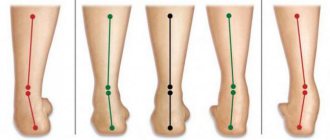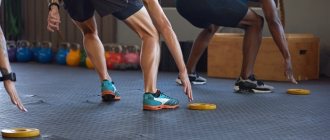Shuttle running is running at speed for short periods in two directions several times. The length of the segments varies, but the sum rarely exceeds 80-120 meters. Shuttle running is an integral part of the training of athletes from team sports: football, hockey, basketball, volleyball, handball, mini-football and others, that is, those sports where speed, agility and good coordination play an important role in achieving results. This type of running has also become widespread in some areas of fitness, including CrossFit.
What is shuttle running
Shuttle running, being undoubtedly a type of cross-country athletics, was not included in the program of athletics competitions, but gained prestige in schools in physical education classes, in the “Ready for Labor and Defense” (RLD) complex and became a mandatory physical fitness test for employees law enforcement agencies.
Shuttle running is running over a short distance with a constant change of direction between two points. Simply put, running back and forth. The runner starts to the designated point, runs around it or touches the line and returns to the start along the same route, repeating the combination up to 10 times. Everything is very simple, but at the same time it is not at all easy for your body.
How to prepare for passing FISO standards: main rules
Types and distances of shuttle running
Types of shuttle running can be completely different both in execution technique, the distance between the points run, and the number of repetitions. In general, three types will be the most popular:
Subscribe to “Marathon Man” on Telegram. Announcements of articles and useful selections every week.
- 3x10 – this distance is for elementary school students and it is also included as a standard in the GTO complex. The test taker is required to run a distance of 10 meters back and forth three times.
- 4x9 - this type of shuttle running is used in physical education lessons in high school.
- 10x10 - This distance and number of repetitions is used as a test of physical fitness in the power structures. This is where the real test of dexterity and coordination lies!
In addition to the above-mentioned types, there are also those when a person runs in one direction facing forward and returns with his back. The length of one line is often 10 meters, but can reach up to 100 m. In some shuttle races you need to run around the end point, and in others you need to turn around, touching it with your hand, etc.
source: michaelhoeweler.tumblr.com
As you can see, the variations of what the shuttle run will be like depend on your imagination. That’s why shuttle running is more of a type of general physical training (GPP) than athletics, so it would be logical to continue our article with an answer to the question: what qualities does such running develop?
What is the essence of such a movement?
This type of activity involves walking a distance in different directions for a certain time, several times in a row. The length of the distance should not be more than 100 meters. Such running is one of the very important parts of the training of basketball players, boxers and other athletes.
This is due to the fact that such training allows you to develop endurance, coordination and dexterity. In addition, it significantly helps to increase starting speed. For each age, special indicators have been determined; the norms of the first stage of the GTO complex are the most lenient.
What qualities does shuttle running train?
When performing a shuttle run, you develop high speed to run a short distance to the end point, but almost immediately you need to turn around to run back, and so on a certain number of times. This is where the sense of balance is activated to the maximum, a large number of muscles are involved, coordination and your speed qualities develop.
As general physical training, shuttle running is a mandatory training program for football players, tennis players, hockey players and other athletes, where running is present, but along an inconsistent trajectory.
To diversify your running workouts, you can also include shuttle running. It will help you develop resistance to changes in pace, develop general motor skills of the body, speed-strength qualities, and explosive power of the leg muscles.
And if you are preparing for a start where there are sharp turns or even 180-degree turns, you will get the maximum benefit from shuttle running, since you will be ready to quickly change direction without losing speed.
Physical Fitness for Runners: 30 Bodyweight Exercises
Sneaker selection
You cannot train in the shoes you wear every day to work, for a walk, to a store or a cafe. A special type of shoe is designed for this - sneakers, designed in such a way as to provide comfort even during intense workouts and prevent injuries.
But just as diverse are the types of training, so are the variety of sports shoes - sneakers for fitness, running, gym or crossfit. You can get overwhelmed by the variety of models. Let's look at shoes for running and the gym.
Shuttle running technique and basic mistakes
Shuttle running is performed on a flat surface with a hard surface. Your shoes should not be slippery. Before you start exercising, warm up well: under no circumstances should you start this traumatic type of running with unwarmed muscles!
The execution technique will depend on the distance: for the short one you should use your full speed potential, and for the long one (10x10 or races with segments of 100 meters), perform the first half at medium intensity, accelerating towards the final segments.
Video: technique for performing the 3x10 meter shuttle run from the All-Russian Sports Society "GTO".
The remaining technical aspects are the same:
Start
- Taking the starting position (high start), place your supporting leg forward and move the center of gravity of the body to it. Lean your body forward, but do not bend your back. Focus power in your quads for an explosive start.
Movement along the distance
- On the command “March!” you must reach the end of the segment, touch the line or any other object and return to the starting line. To maintain maximum speed over such short distances, land on your toes rather than your entire foot.
Rotate 180 degrees
- The whole highlight of shuttle running is the turn, which forces the athlete to first slow down and then pick up speed again. To properly perform a turn, you need to apply a stopping step as you approach it to reset the momentum. Turn around like this: turn the foot of your front leg at a right angle in the direction of the turn, turn your body sideways and push off with your forward leg.
Breath
- It is recommended to breathe in a 2x2 pattern, which means two steps as you inhale and two steps as you exhale.
Errors
Main mistakes if you pass the GTO standard:
- false start;
- failure to cross the line during a turn;
- interfering with other test takers.
You will not receive credit for these mistakes.
The following errors can hinder a good final time:
- You have distributed the load incorrectly. On a short distance of 3x10 meters, you should work to your maximum from the very beginning, but when covering 10 segments, try not to become exhausted in the first half.
- Slow braking before turning. A stopping step does not mean a gradual reduction in speed; with a stopping step, you are preparing your leading foot for a sharp turn. In other words, it's like you're stopping while you're turning, but by maintaining momentum, your speed doesn't drop.
- Having become accustomed to turns, athletes often make the unfortunate mistake of braking before the finish line. Remember, when you have passed the last turn and started running for the last stretch, you must go through it as fast as you can, crossing the line.
Shuttle running training program
Are you preparing to pass the GTO standards? Then this block is for you! Below we will provide a table of standards for age categories, but for now we will tell you how to prepare for testing.
It is better to conduct classes at an athletics stadium with a rubber track. This is the coating that will hurt your feet the least. Don’t even consider asphalt, and especially concrete, for training.
In the methodological literature, beginners are encouraged to use the following combinations on different training days:
- 3 sets according to the 4x9 pattern;
- 5 sets 4x9;
- 3 sets of 4x15;
- 5 sets of 4x15;
- 3 sets of 4x20;
- 1 race according to the 10x10 pattern.
To progress, it is also recommended to include work with a jump rope in your classes to strengthen your foot for toe running: jumping will increase the power of the musculoskeletal system, pump up the calf muscles and give you a powerful push-off while running. For jumping exercises, use side jumps. With them you will increase the strength of those muscles that work when gaining speed after a turn.
Practice shuttle running at low speed first, and when your muscles adapt to such work, increase the pace. And, of course, before performing sets, do not forget to do a thorough warm-up, including:
- jogging at an easy pace – 10-15 minutes;
- general developmental and special running exercises – 10-15 minutes;
- acceleration by 50-60 meters with an emphasis on running on the toes - 2-3 repetitions.
SBU complex: 9 special running exercises with video
pros
The benefit of this type of exercise lies in the complex load, which develops:
- coordination;
- speed qualities;
- sense of balance;
- dexterity;
- strength;
- endurance;
- motor skills of body muscles.
In addition, the body undergoes such positive changes as:
- the cardiovascular system is trained;
- blood flow and metabolic processes improve;
- the body is cleansed of toxins;
- weight loss;
- immunity is strengthened;
- fatigue is relieved.
Standards for shuttle running
Let's consider the standards for shuttle running at a distance of 3x10 meters, which is taken by children and adults in the GTO.
Men
Table of standards for shuttle running, men
Women
Table of standards for shuttle running, women
For adults aged 30 years and older, shuttle running is not included in the program for passing the GTO standards. This is due to the fact that after 30 years the condition of bone tissue and the elasticity of ligaments and joints gradually deteriorate.
Employees of the Ministry of Internal Affairs and the Ministry of Emergency Situations pass shuttle running standards at distances of 10x10 meters and 4x20 meters, but the scoring grid is too fractional, so we leave for readers a link to the resource: standards of the Ministry of Internal Affairs and the Ministry of Emergency Situations. If an employee does not meet the specified standard, he is sent for recertification.
How to run correctly
Rest between sets is 15 seconds, between exercises - 30 seconds. The exercises are the same as on Monday.
The standards for the 3*10 m shuttle run for schoolchildren are developed depending on age (7-17 years), gender and level of training (high, medium, low). Raising arms and legs while sitting.
The athlete sits on the floor, stretches his arms in front of him and raises his legs. At this moment, the legs should be spread, and the arms, on the contrary, should be brought together.
Shuttle running allows you to train in the gym in unfavorable weather, because... For this exercise you need a small area with markings for the beginning and end of intermediate distances. If we consider a shuttle, where there are 5-10 m between the markers, then you can certainly run 5 markers there without stopping.
How to train shuttle running?
This year I was able to run fully and, trying my best, ran in 25 seconds (my record is 24 seconds). A few days later I decided to try walking like I did a year ago. I showed the same time!!! As a single remedy, she is also advised to run 4:70 for small volumes (6-10 km/day).
Speed endurance
The initial start is most often used high with support on one hand, but other start options are also allowed. After passing each intermediate distance in the opposite direction, at the start the technique of braking and subsequent acceleration is used.
Sprint with change of direction
Turns require mastering a stopping step; this step, in addition to shuttle running, is most often used in basketball. The shuttle running standards of 10*10 and 4*9 m were developed for military personnel and boys in grades 9-11.
At its core, this is short-distance running, only the number of races in one cycle is more than one.
The athlete runs a short section of the path once, turns around, runs back along the same route, repeats the exercise, etc.
Attention!
With the help of such exercises, athletes train to accelerate quickly, start and finish on time. It is also suitable as a warm-up exercise to improve speed in sprinters.
It is necessary to start the lesson, as in the standard complex, from the starting position. It can be either low or high. Special foot rests are not used in shuttle running. And it is better to refrain from the finishing jump; today even professional sprinters have become convinced of the low effectiveness of this technique.
During the game, hockey players need to be able to quickly develop and slow down speed over a period that lasts only 30-45 seconds. S.E. Pavlov: An athlete’s training should be based on reference to energy supply modes, the increase in power and capacity of which constitutes a resource for the development of sports.
It is this complex that is trained in the process of performing certain work. It is also not clear that many coaches often chase gigantism in players, giving preference to players who may be big but have problems with coordination, speed, and endurance.
This will make it possible to track and compare the results obtained. The distance increases from 1 km to 3 km. The running pace is slightly above average; by the end of the cycle it should be brought to 70-80% of the maximum. Table 1. In this case, the hand is always raised behind the supporting hand, and the legs remain in place. The exercise is performed clockwise and counterclockwise.
You love games with team running and have long guessed that you can run fast in different ways, but did not know how to comprehensively develop your speed qualities
After push-ups, without rest, the athlete walks on his hands along the entire length of the bars in one direction and the other. The number of approaches depends on the player’s level of training. In principle, these are all simple exercises that do not require the use of any complex machines or barbells. But the use of these exercises helps to develop the strength and power of the athlete.
Running with a partner. For 60 seconds, the running is carried out at a low pace; on command, the players start sharply and run at a high pace for 15 seconds. Then run again at a low pace. This is repeated 10 times. On Tuesday and Friday we work on the complexes. The player is constantly in motion, but at the same time he performs various strength work.
Complex 1. This exercise is performed at a distance of 25-30 meters. 10 repetitions are performed in one approach. Jumping with a partner. On Mondays and Thursdays, all exercises related to fast running. The speed of the exercise should be close to maximum.
The exercises are performed in 3 approaches, the first two approaches are done with weights, and the last approach without them. The “start” command is given with a wave of the hand and voice. The player starts from different positions: low start, prone position and low start with his back to the distance. Running with turns. The exercise is performed for 40 seconds. Running sideways. At a distance of 60 meters, racks are installed in a checkerboard pattern.
But the question immediately arises: to run or not to run short accelerations?
The player stands inside this “cross” and begins to run quickly in place, then jumps over the ball, takes several steps and jumps back to the starting position. After a few steps inside the figure, he jumps over another ball. The exercise is performed for 15 seconds. It is considered that the speed is there or not. This is an excuse not to work.
Movements are performed in one direction and the other. “Break”. The athlete, while jumping, pulls the foot of his left leg towards his right knee and slams his palm on it.
Torsion is performed forward and backward. Hyperextension with gripping the legs with the hands. In this position, he tries to bend even more and holds his legs for 20 seconds. Hyperextension with rotation.
Important!
The athlete takes the position as in the previous exercises. This is one approach. In principle, physically the player is in good shape.
Considering that the training was carried out only with his own body weight, his muscles are not clogged, they are strong and elastic.
On the subject: How to motivate yourself to jog in the evenings
The athlete stands with his back to the distance, puts his foot on the ball and begins to move. At the same time, he jumps on the supporting leg, and with the other leg, which is on the ball, he rolls it behind him. When returning back, the ball is dribbled with the other foot. Work with soccer and basketball balls.
The player begins lateral movements from post to post while dribbling the ball. The return is carried out backwards. Dribbling and throwing. He starts dribbling, on command he turns around in a jump and makes a throw into the hoop.
If the guarding player forces the ball to be lost, then he must pick it up and throw into the hoop. Throwing the ball for American football.
Not only is the player constantly in motion, he is under forceful pressure, he plays on skates and holds a stick in his hands.
In this case, it is recommended to play one on one, one against two, and the so-called “sun” (several players stand around the perimeter of the table and start running around it, hitting the ball).
At work, we periodically take physical exams. standards, and in the cold season it includes a shuttle run of 10 by 10m. A year ago I had a back injury and could not fully run. To understand how to run shuttle running, you need to focus, first of all, on your speed limit. It should be maximum, because this is precisely what this complex was developed for.
Source: https://folkasernover.ru/kak-pravilno-begat/











